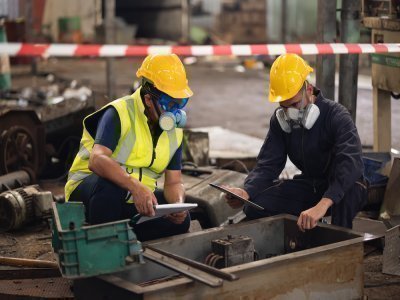Workplace Exposure Limits Are Changing
What Australian Businesses Need to Know
From 1 December 2026, Safe Work Australia will replace the current Workplace Exposure Standards (WES) with enforceable Workplace Exposure Limits (WEL). These limits define the maximum amount of hazardous substances, such as respirable silica and diesel particulate, that workers can safely be exposed to.
At JTA, we help Australian businesses Detect. Protect. That means identifying workplace hazards early, protecting workers from harmful exposure, and helping you meet your legal obligations without disrupting operations.
This article outlines:
- What’s changing and why
- Which businesses are affected
- How to manage chemical and physical hazards
- How JTA can help you comply and protect worker health
What Are Workplace Exposure Limits?
A Workplace Exposure Limit (WEL) is a legally enforceable occupational exposure limit (OEL) for airborne contaminants in the workplace. These limits typically refer to a time-weighted average (TWA) exposure over an 8-hour workday.
Previously referred to as Workplace Exposure Standards (WES), the term change reflects international terminology and clarifies their enforceability.
WELs are designed to protect workers from hazardous chemicals and substances that may cause long-term health effects such as respiratory disease, cancer, or hearing loss.
What’s Changing from WES to WEL?
Safe Work Australia is aligning its approach more closely with global best practices, such as those from the National Institute for Occupational Safety and Health (NIOSH) in the United States.
Key Changes:
1. Updated Limits for Airborne Contaminants
The exposure limits are being reviewed for 9 key contaminants:
- benzene
- chlorine
- copper (fumes, dusts and mists)
- formaldehyde
- hydrogen cyanide
- hydrogen sulphide
- nitrogen dioxide
- respirable crystalline silica
- titanium dioxide
These are based on scientific evidence of health risks.
2. Substances Removed from the List
Thirty-three non-threshold genotoxic carcinogens [TT1] have been removed from the WEL list. Regulatory authorities now manage these substances under other pathways for hazardous chemicals.
Why the Change Matters
These new limits are not just recommendations - they’re enforceable exposure limits that employers must not exceed. The shift signals stronger enforcement and an expectation that Australian businesses take workplace air sampling and risk assessment seriously.
If your workplace exceeds these limits, you may face:
-
Regulatory enforcement
-
Legal liability
-
Loss of contracts or certification
-
Reputational damage
“Organisations that take early action don’t just stay compliant — they often uncover efficiency and safety wins they hadn’t expected.”
— Jackson Trotman, Technical Director, JTA
Who Is Affected?
These changes apply to any workplace that deals with hazardous substances, especially airborne contaminants. If you use tools, equipment, or materials that create dust, fumes, vapours, or gases, you will feel the effects.
High-risk industries include:
- Manufacturing: welding, machining, spraying, sanding
- Construction & Civil Infrastructure: concrete cutting, jackhammering
- Utilities & Public Works: depots, pumping stations, diesel equipment
- Transport & Rail: diesel exhaust, brake pad dust
- Schools & Councils: workshops, groundskeeping, maintenance crews
- Even if you aren’t directly creating hazardous airborne substances, subcontractors or shared sites may expose your staff to physical hazards or chemical hazards.
What Should You Do?
Now is the time to assess your current exposure controls, understand how new limits apply to your workplace, and take practical steps to stay ahead of enforcement deadlines.
If you are a PCBU, you should prepare for the adoption of the WEL during the transition period, ending on 30 November 2026. You should do this by identifying, assessing and controlling the risk posed by the airborne contaminant hazard.
Identifying the hazard – you should consult the WEL list to see what airborne contaminants you use or generate in the workplace and the new limits after 1 December 2026 are. If you are already aware of the airborne contaminants in your workplace, check the WEL list to see if the limit has changed.
Assess the hazard – You must ensure that no worker is exposed to an airborne concentration of an airborne contaminant that is higher than the WEL. If you unsure about whether you exceed the WEL or not, you must conduct air monitoring.
Control the hazard – You should identify and implement appropriate controls to implement to ensure that your workplace does not exceed the WEL. You should always aim to eliminate the airborne contaminants. But if it is not reasonably practicable to eliminate the hazard, then you must minimise the risk posed by the hazard by following the hierarchy of controls. You should review your control measures to make sure they work as planned
How JTA Can Help
At JTA, we Detect. Protect.
We’ve been delivering workplace health and safety consulting for over 35 years — and we specialise in managing both occupational exposure limits and on-the-ground compliance solutions.
We offer:
✅ Workplace Exposure Risk Reviews
✅ Air Sampling and Monitoring for key contaminants
✅ Risk Assessments aligned to WEL, PEL, and REL standards
✅ Engineering Controls and Ventilation Advice
✅ Staff Training and PPE Guidance
✅ Regulatory Reporting and SDS Compliance
Our services are tailored, scalable, and industry-specific — whether you run a manufacturing plant, a utility depot, or a mobile construction crew.
Why Partner with JTA?
Every workplace is different. That’s why we deliver practical, cost-effective solutions that protect your workers, limit liability, and improve safety culture.
We don’t just help you meet standards — we help you improve operational performance by identifying smarter processes and better controls.
Act Now — Before the 2026 Deadline
You have until 1 December 2026 to meet the new WELs — but compliance takes time. The sooner you start, the more options you'll have to upgrade controls gradually and cost-effectively.
Let JTA help you:
- Understand your WEL obligations
- Benchmark your current risk profile
- Protect worker health and wellbeing
Ready to Take Action?
Book a Workplace Exposure Risk Review today
Get a Quote/Book Online
OR
Call Us on 1300 856 282
References
1 https://www.pnas.org/content/118/17/e2018995118









